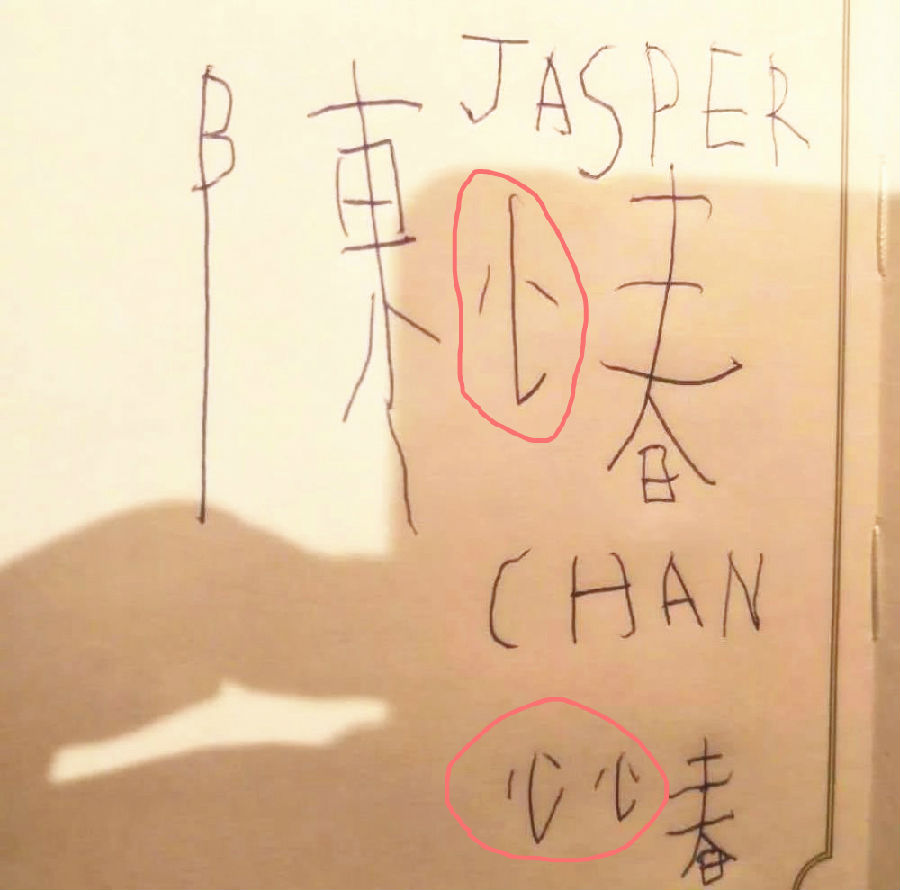This here is a pile of keepsakes from preschool.
这是一堆我幼儿园时纪念品。
So what we have is just a standard family portrait, some smiling cat, masterfully drawn rainbows and flowers, and then there's this.
这是一张标准的全家福,这是一只在笑的猫,大师手笔的彩虹和花儿,接下来这个就厉害了。
It's my name written completely backward.
这是我名字,不过完全是反着写的。
Weird right?
很奇怪,对吧?
Except I used to do this all the time.
不过,我以前一直都是这么写的。
If it wasn't my full name, it was usually just a random letter or number, like I did with the 'G' in kindergarten.
即便不是整个名字都反着写,也经常会有一个字母或数字之类的写反了,就比如这里的“kindergarten”(幼儿园)里的“g”我就写反了。
It's called mirror writing, and most kids under the age of 7 have done it at some point, in some form.
这种书写方式叫作“镜像书写”,7岁以下的孩子大部分都在某个时间点以这样或那样的方式经历过这个阶段。
It seems kind of ridiculous now, but it's completely normal.
这种行为现在回头来看似乎有点可笑,但它其实是非常正常的。
It's just a sign of how our brains evolved to see the world.
它只不过是我们大脑认知世界的方式有一个成形的过程的标志。
Learning to write is kind of hard.
习字是有一定难度的。
First, we have to understand a string of abstract shapes,
首先,我们得理解一大堆抽象的形状,
then, as we learn, we have to understand that, in English, script goes from left to right.
然后,随着我们的学习,我们还得知道,在英语中,字母是从左往右书写的。
Early on, before really understanding which direction to write in,
一开始还不太知道朝哪个方向书写的时候,
kids like me just wrote where there was empty space available.
和我有一样问题的孩子就会哪儿有空位就往哪儿写。
So if I put a 'K' on the right edge of the page, I just wrote the rest of my name into the empty space on the left.
换句话说,如果我在一页纸的右边沿写了一个“K”,那我名字里剩下的字母就只能往左边的空位写了。
"I would be willing to bet that you started with the letter K,
“我敢打赌你是从字母K开始下笔的,
because you know that "K" is the first letter of your name and they progressed in the right-to-left direction –
因为你知道‘K’是你名字的第一个字母,然后从右往左写——
writing the K backwards, the I and the M would also be written backwards,
反着写‘K’,‘I’和‘M’也应该是反着写的,
but we don't see that because they look exactly the same."
不过我们看是看不出来的,因为这两个字母正着写反着写都是一样的。”
Rob McIntosh has studied various forms of mirror writing for years.
多年来,罗布·麦金托什一直在研究各式各样的镜像写作。
"Much more common, actually, is just partial mirror writing.
“事实上,比较常见的是局部镜像书写。
Where the script might go in the correct direction but individual letters will be reversed.
也就是说,整体书写方向是对的,只是个别字母写反了。
So maybe the letter "d" is written as a "b" or "b" is written as a "d.""
比如,可能把字母‘d’写成了‘b’,或者“b”写成了“d”。
You might be thinking, "So what?
你可能会说,“那又怎样?
Kids are still learning and just don't understand the shapes yet."
孩子还在学,还不理解那些形状而已。”
But it's not likely for a kid to take that same letter and flip it completely upside down.
问题是,他们是不太可能把一个字母上下的方向写反的。
And we're not talking about them confusing one letter for another entirely.
而且,我们讨论的并不是他们完全混淆两个字母。
Remember, I didn't use the wrong shapes.
记住,我并没有写错形状。
I used the right ones.
形状是对的。
In the right order – just backward.
顺序也是正确的——只是反着写了而已。
So how did I manage to do that?
那我是怎么做到的呢?
"The short answer is that children can't tell these mirror images apart at this stage.
“长话短说就是,这个年龄段的孩子是分不清字母镜像前和镜像后的区别的。
You know, we tend to think that it's children are bad at discriminating the mirror images,
我们倾向于认为是孩子不善于辨别镜像,
but we might turn that around and say that actually that children are very good at generalizing across mirror image forms.
但我们不妨换个角度,认为是孩子非常擅长超越镜像把握总体特征。
And it seems to be that that's something the human brain is set up do."
而且,貌似人类的大脑天生就具备这种能力。”
There's a name for this inability to tell mirror images apart: "mirror generalization" and our adult minds do it all the time too.
这种无法区分镜像的现象还有一个名字:“镜像概括”,我们成年人的大脑也一直在这么做。
Think of the Statue of Liberty.
大家不妨回想一下自由女神像的样子。
You can probably picture that it's a green statue that holds a torch but...
你大概能在脑海里绘制出一座举着火炬的绿色雕像,问题是……
"What hand is the torch in?"
“拿火炬的是哪只手?”

"I'm trying to think if I picture."
“我正在回忆。”
"Oh, God."
“啊,我晕。”
"Oh, I have no idea."
“啊,完全没印象。”
"I mean 50/50 guess, I'm gonna say the right hand."
“反正对错比例对半开嘛,我猜右手。”
"Left?"
“左手?”
"Torch is in the right hand."
“火炬在右手上。”
"Left."
“左手。”
"Are you sure?"
“你确定?”
"No."
“不确定。”
And you can probably describe the Apple logo.
大家不妨再描述一下苹果的logo。
..a silhouette of an apple with a bite mark out of it...
..一个苹果的轮廓,上面有一个咬痕.。
But..."Which side is the bite taken out of?"
问题是……“被咬的是哪边?”
"Oh my god. I look at this every single day."
“我晕,我每天都在看这个啊。”
"If I'm looking at it?"
“从我的角度看吗?”
"Yes."
“是的。”
"It's on the left side of the Apple."
“咬痕在苹果的左边。”
"I want to say the right side."
“我站右边。”
"Uh, the left side."
“嗯,左边。”
"The left side."
“左边。”
The trouble is that orientation as in the left or right direction something is facing is rarely committed to memory –
问题是,某个东西是朝左还是朝右这种方向问题很少会在我们的脑子里停留很久——
because in the natural world it doesn't really matter.
因为在自然界,这个问题其实并不是很重要。
When we see it an animal facing to the left,
即便一只动物在我们看到它的时候是朝左边的,
we'll still recognize it as a dog when it turns around.
它转过来我们也照样能认出它是一条狗。
When I'm sitting to the right of someone,
当我坐在一个人的右边时,
I'm not suddenly shocked when they turn to face me or move to my left.
就算他们转过来面向我或是挪到我左边,我也不会觉得吃惊。
"Most objects in nature don't change their identity depending on which way round they're facing."
“自然界中的大多数物体都不会因为朝向而改变身份。”
Trees, plants, and animals basically look the same one way or another.
有的树木,植物或动物这么看或者那么看都是一样的。
So our brains cut corners to allow us to recognize these things quickly and commit them to memory without focusing on direction.
所以,在这个问题上,我们的大脑抄了个小路,让我们不用关注方向,也能快速认出那些东西,并把它们记在脑海里。
So when it comes to letters and numbers and other things that depend on orientation,
所以,当涉及到字母,数字或其他依赖于方向的东西的时候,
we have to work a little harder to remember which way is right.
我们只能努力一点才能记住正确的方向。
"We have to sort of suppress the tendency to automatically generalize."
“我们只能,在一定程度上,压抑我们原来的那种自动概括的倾向。”
"Which is actually an amazing feat.
“这点其实还挺不可思议的。
Our brains have evolved to mirror generalize – and we've taught them when and how to turn that skill off."
我们的大脑进化出了镜像概括的能力,然后,我们又教会了它们什么时候关闭,以及怎么关闭这种技能。”











